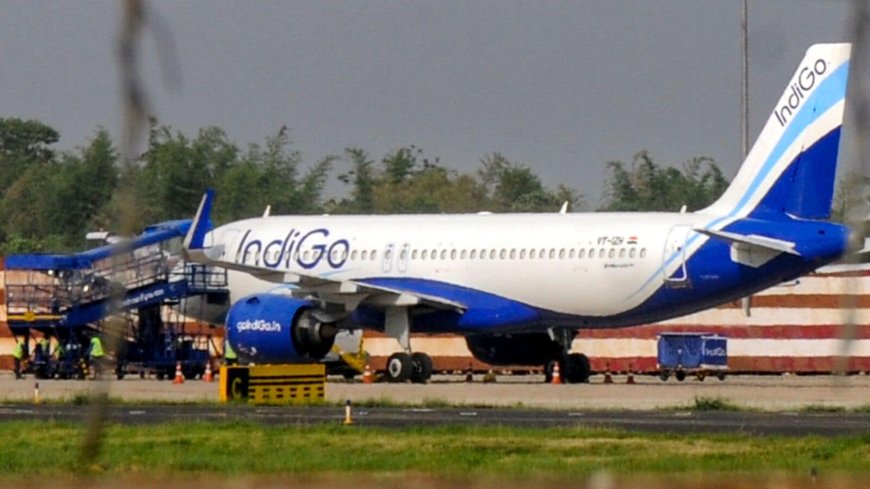IndiGo Q1 Results: Net Profit drops 20% to ₹2,176.3 crore; revenue up 4.7%
InterGlobe Aviation (IndiGo) Q1 FY26 results show a 20% YoY decline in net profit to ₹2,176.3 crore, while revenue increased by 4.7%. High fuel costs and forex losses weighed on earnings.

InterGlobe Aviation Ltd, India’s largest airline operating under the brand name IndiGo, reported a 20% year-on-year drop in net profit for the quarter ended June 30, 2025, to ₹2,176.3 crore, down from ₹2,666.2 crore in the corresponding period last year. This comes despite a 4.7% rise in revenue, which stood at ₹17,161.6 crore compared to ₹16,683 crore in Q1 FY25.
The subdued bottom-line performance was primarily driven by a combination of higher operating costs, foreign exchange losses, and ongoing engine supply constraints, which affected capacity growth and disrupted operations.
Revenue Rises, But Operating Metrics Strained
IndiGo’s revenue growth was supported by robust passenger demand and stable load factors. The company saw an ASK (Available Seat Kilometres) increase of 11.3%, and passenger ticket revenues rose 5.2% YoY to ₹15,730 crore. Ancillary revenues also showed a healthy uptick of 7.6%.
However, total expenses rose faster than revenue, increasing by 13.3% YoY to ₹14,821 crore. Fuel costs, which represent the biggest expenditure for airlines, rose nearly 9% due to a combination of higher global crude prices and the depreciating rupee.
The EBITDAR (Earnings Before Interest, Taxes, Depreciation, Amortization and Rent) margin narrowed to 22.4%, down from 26.8% in Q1 FY25.
Forex Volatility and Engine Issues Impact Margins
In a statement accompanying the earnings release, IndiGo said it recorded a foreign exchange loss of ₹210 crore for the quarter, significantly impacting profitability. The rupee’s weakness against the US dollar continues to hurt Indian carriers, which incur substantial costs in foreign currency for leasing aircraft, maintenance, and fuel.
Additionally, engine supply issues from Pratt & Whitney continued to plague IndiGo’s fleet availability. The airline had to ground several aircraft due to engine inspections and replacements, leading to capacity underutilization and operational inefficiencies.
CEO Commentary: Focused on Long-Term Expansion
IndiGo’s CEO, Pieter Elbers, acknowledged the challenges in the short term but remained optimistic about long-term growth.
“While cost pressures and supply chain issues have moderated our near-term margins, we remain committed to building capacity and expanding our international footprint. We’ve added new routes and bolstered frequencies to support our ambitious growth targets,” Elbers said.
He also emphasized that the airline continues to invest in fleet modernization, customer experience, and international expansion to position itself for sustained growth in the future.
Market Context: Aviation Sector Navigating Headwinds
The aviation sector in India has experienced strong demand recovery post-COVID, but cost pressures, especially from volatile fuel prices and currency depreciation, have created turbulence in earnings. IndiGo, with a dominant domestic market share of over 60%, has been relatively better placed than smaller peers to absorb shocks.
However, global headwinds such as geopolitical instability, volatile ATF (aviation turbine fuel) prices, and supply chain constraints remain persistent challenges.
According to aviation analyst Vikas Jain from ICICI Securities:
“The Q1 result reflects the rising input cost environment and the impact of grounded aircraft due to engine issues. Investors should focus on IndiGo’s ability to manage costs while continuing its expansion strategy.”
IndiGo Stock Reacts Muted; Analysts Stay Cautious
Following the results, IndiGo’s stock showed a muted reaction on the NSE, closing marginally lower at ₹3,074. Market participants appeared to have priced in the earnings dip, as earlier guidance from management had indicated challenges for Q1.
Brokerage firms remain mixed in their outlook. While some have maintained a ‘Buy’ rating citing long-term prospects, others recommend ‘Hold’ due to near-term headwinds.
“While we remain constructive on IndiGo for the medium term, elevated costs and forex pressures may limit earnings upgrades in FY26,” said Kunal Shah, aviation analyst at Edelweiss Securities.
Investor Outlook: Long-Term Strategy Holds Promise
Despite the near-term earnings decline, IndiGo’s resilient balance sheet, strong domestic presence, and international expansion plans continue to offer comfort to long-term investors.
The airline’s current fleet of 360 aircraft is expected to grow substantially with 500+ planes on order, including fuel-efficient Airbus A320neos and XLRs, which are expected to lower cost per available seat kilometre (CASK) over time.
“Investors should watch Q2 and Q3 closely, especially regarding capacity deployment, forex trends, and updates on engine replacements. The long-term story remains intact,” noted Anita Menon, a sector analyst at Motilal Oswal.
IndiGo’s Q1 FY26 results highlight the growing strain of cost inflation and operational disruptions even as demand stays buoyant. A 20% decline in net profit underscores the importance of cost control, efficiency, and managing macroeconomic headwinds.
Yet, the airline's revenue growth, robust passenger demand, and strategic long-term focus provide a foundation for recovery in the coming quarters. As IndiGo navigates this phase, stakeholders will closely monitor its ability to turn around margins while capitalizing on India’s growing air travel market.
What's Your Reaction?
 Like
0
Like
0
 Dislike
0
Dislike
0
 Love
0
Love
0
 Funny
0
Funny
0
 Angry
0
Angry
0
 Sad
0
Sad
0
 Wow
0
Wow
0













































































